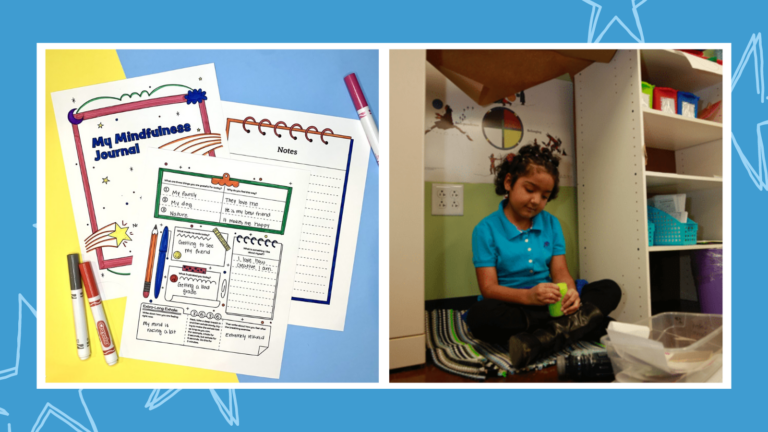Right now, if our lives were a play, it feels like COVID-19 has the lead role and is front and center on the main stage. Meanwhile, over in the wings, we are still carrying on with “business as usual,” even though nothing is like it was before. For our students, this is their experience of school right now (imagine starting 9th grade in 2020!). They still need to learn the Pythagorean Theorem, learn how to write a thesis statement, and make it to their classes on time. And yet, they wear masks to school, can’t go to their friends’ houses, and their parents are worried all the time. While they sit in their third Zoom class of the day, trying to pay attention, their minds wander: Will I have a virtual high school graduation? Will my mom find another job? Will the world ever be the same again? This is where practicing mindfulness practices can help.
Mindfulness is a teaching tool
It’s hard for students to focus when they are experiencing stress and anxiety. The classroom hasn’t traditionally been a place for sharing feelings, but this is changing. Mindfulness in schools reduces stress and lengthens students’ attention spans. Schools are realizing that academics aren’t isolated from a student’s mental health and emotional experience of school. How we react to stress makes all the difference, and mindfulness practices are a tool we can use in our teaching to help our students learn to respond not react.
Start with small mindfulness practices that have a big impact
We found free comprehensive mindfulness resources that are small shifts you can build into your teaching. These resources come from mindfulness professionals at IBM and The Oxford Mindfulness Centre. Plus, they offer a free self-paced mindfulness course for teens, so you have a lot to work with. We pulled four of our favorite strategies from the course to help you get started.
1. The Stop Technique
If you notice your students are super stressed when they have to abruptly transition from one subject to the next, this one is for you. Five minutes isn’t a lot of passing time! The Stop Technique gives students a chance to take a breather before they go into your room. Here’s how it works. First, ask students to stop and take a breath. Then, invite students to observe what’s going on as then they enter the room.
Tracy Zakavec, a P-TECH teacher at Skyline High School in Longmont, Colorado, hopes this strategy will help her students de-stress. “I would like it when they enter my room for it to be a place where hopefully it is calming and not as stressful.” She uses the Stop Technique and has noticed that her students are ready to learn when they have a smoother entry.
2. Just Listen
It’s hard for students to listen to us and each other when there are so many other things going on in their minds. Use this strategy to help your students re-focus.First, ask students to close their eyes. Then, tell them to focus on noticing what they hear. These can be sounds in their mind or in the room. Encourage them not to judge but to notice. Once they open their eyes, ask them to jot down some of the sounds they heard.
3. Stand and Stretch
Mindfulness is a tool we can share with our students to help them calm down their nervous system and reset. You hear about calm down corners, brain breaks, and coloring sheets in elementary classrooms, but younger students aren’t the only ones who need to rest when they feel frustrated or unable to focus. This strategy is simple. Invite your students to stand up and stretch. Ask them to inhale as they raise their arms and exhale as they lower them. After they’ve done it a few times, ask them what they notice. This strategy helps students make a mind-body connection, which is the foundation for becoming more aware of their feelings so they can respond rather than react.
4. Five Finger Gratitude
Sometimes it’s hard to feel like anything is going your way. There’s a lot of stress in high school. Teaching your students a gratitude strategy can help them learn how to manage tough situations and become more resilient. Ask students to think of five things they are grateful for. (It’s helpful to model this one so students don’t feel like there is a right or wrong way to do it). You can say you are grateful for a hot cup of coffee, your dog, a new book by your favorite author, your parents, and pepperoni pizza (whatever’s on your list that day!). Students start to learn how to put things in perspective, a tool that will help them in their future personal and professional lives.
Here’s what students are saying:
https://youtube.com/watch?v=MPaQNXMBpOE
Get started with mindfulness through Open P-TECH. Sign your students up to help them learn skills that will reduce stress, manage anxiety and make it easier for them to learn in these trying times



